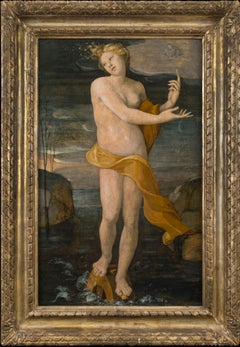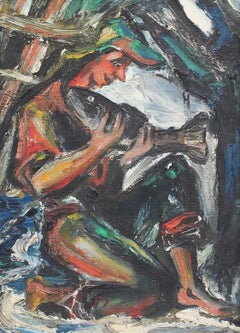Alfred Aaron Wolmark Art
Alfred Aaron Wolmark was a painter and decorative artist. He was a pioneer of the New Movement in Art. Wolmark was born into a Jewish family in Warsaw. He emigrated to London, and became a British citizen in 1894. Returning briefly to Poland in 1903, Wolmark painted works based on Jewish historical subjects. In 1911, under the influence of modern French painting, he executed a series of studies of Breton fisherfolk and harbor life, 1911. Wolmark worked in the areas of interior decoration, the theater and stained glass, 1911–15. He made a stained glass window for St. Mary's Church in Slough in 1915. Wolmark painted a series of cityscapes in New York City, 1919–20. He held many exhibitions in London, New York and Paris, including portrait drawings at the Lefèvre Galleries, 1928. A retrospective of his work was held at Ferens Art Gallery, Kingston upon Hull in 1975. Wolmark’s paintings are now in many galleries around the world, including the National Portrait Gallery, London, Sheffield and Derby Museum and Art Gallery. Wolmark was one of the prime movers in setting up the Ben Uri Art Society, 1915.
Early 20th Century Alfred Aaron Wolmark Art
Oil
Early 20th Century Modern Alfred Aaron Wolmark Art
Canvas, Oil
16th Century Old Masters Alfred Aaron Wolmark Art
Oil, Panel
1950s Modern Alfred Aaron Wolmark Art
Canvas, Oil
1960s Modern Alfred Aaron Wolmark Art
Canvas, Oil
1950s Modern Alfred Aaron Wolmark Art
Canvas, Oil
Mid-20th Century Modern Alfred Aaron Wolmark Art
Canvas, Oil
Late 19th Century Academic Alfred Aaron Wolmark Art
Canvas, Oil
Early 2000s Contemporary Alfred Aaron Wolmark Art
Canvas, Masonite, Oil
Early 20th Century Impressionist Alfred Aaron Wolmark Art
Oil, Canvas
Early 1900s Modern Alfred Aaron Wolmark Art
Oil, Canvas
1950s Modern Alfred Aaron Wolmark Art
Canvas, Oil
1840s French School Alfred Aaron Wolmark Art
Canvas, Oil
Mid-20th Century Modern Alfred Aaron Wolmark Art
Oil, Canvas
1910s Post-Impressionist Alfred Aaron Wolmark Art
Oil
Early 20th Century Modern Alfred Aaron Wolmark Art
Canvas, Oil




